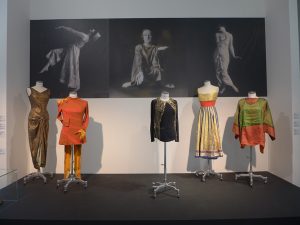In de eerste helft van de twintigste eeuw stelde de dans in Nederland weinig voor. Er was wel enige belangstelling, maar die betrof uitsluitend klassiek ballet. De succesvolle dansvoorstellingen kwamen alle uit het buitenland.
Het is bijna geheel uit de geschiedenisboeken verdwenen dat zich in die jaren een opmerkelijk creatieve en originele danseres en choreografe in ons land vestigde: Gertrud Leistikow (1885 – 1948). Je kunt je afvragen wat ze hier zocht, in een land dat bekend stond als een moerasdelta, maar voor de danskunst een dorre woestijn was.
De culturele buitenplaats Kranenburgh in Bergen (NH) haalt deze bijzondere kunstenares uit de vergetelheid met de expositie Pionier van een nieuwe wereld. Tegelijk met de opening overhandigde de samenstelster van de tentoonstelling, Jacobien de Boer, het eerste exemplaar van haar boek Dans voluit, dat is leven aan de schoondochter van Leistikow, Petra Kreb.

Dans is de meest vergankelijke van alle kunstvormen, althans in de tijd waarin Gertrud Leistikow floreerde en waarin er nog maar weinig op film werd vastgelegd. Er is wel iets van haar danskunst gefilmd, maar deze opnames zijn niet bewaard gebleven. Dit zal een van de redenen zijn dat haar naam uit het collectieve geheugen is verdwenen. Wel heeft Leistikows zoon Igor Jongman twee van haar werken gereconstrueerd (de filmbeelden zijn op de wand van de tentoonstelling te zien), maar je blijft onzekerheid voelen of je echt ziet wat zich destijds op de dansvloer afspeelde.

Leistikow zette zich af tegen de inperkende traditie van het klassieke ballet. Het was een tijd waarin, mondiaal gezien, aardverschuigingen in de kunstgeschiedenis plaatsvonden. Leistikow wilde vrijheid om haar eigen bewegingen te ontwikkelen. Ze introduceerde persoonlijke expressie van emoties in haar dans en zag er, om dat te kunnen doen, geen bezwaar in bewegingen te gebruiken die in die tijd als ‘niet mooi’ golden. Er waren meer danseressen in haar tijd die op deze wijze de grenzen verlegden en de doorbraak van de moderne dans op gang brachten, zoals Isadora Duncan en Mary Wigman. Deze laatste namen zijn bekender gebleven dan die van Leistikow. Hoewel we de dans van Leistikow niet meer kunnen zien, wekt de expositie de indruk dat zij minstens zo belangrijk is geweest voor de moderne dans en de bevrijding van de uitingsmogelijkheden van het lichaam als de andere vernieuwsters. Zonder Leistikow is het werk van Pina Bausch ondenkbaar.

Uit de expositie komt het beeld van een zeer veelzijdig en vernieuwend kunstenares naar voren. Leistikow was niet alleen danseres, ze had de kunstacademie gevolgd, schilderde en maakte ontwerpen. Ook de kostuums en maskers die ze in haar choreografieën gebruikte maakte ze zelf. Op de foto’s, affiches en ander beeldend materiaal op de expositie is uiteraard alleen stilstaand beeld te zien, maar aan de gepassioneerde houdingen, de maskers en andere attributen is af te lezen dat Leistikow geen enkele grens erkende. Het geheel doet serieus de vraag rijzen of Leistikow niet van even grote betekenis is geweest voor de moderne dans als de andere dansvernieuwers van haar tijd. Maar ja, misschien is het, om ècht beroemd te worden, niet slim om in Nederland te gaan wonen. Leistikow trad ook buiten ons land op, zeker in het begin met veel meer succes dan hier.

Dat ze graag in Nederland woonde en werkte zal te maken hebben met de vele contacten die ze hier had in kunstenaarskringen. Ze had een bloeiende lespraktijk en telde veel kunstenaars onder haar vrienden. De tentoonstelling laat hier veel van zien, niet alleen aan de hand van foto’s, maar ook met kunstwerken. Jan Sluijters schilderde haar. Mommie Schwarz maakte in 1925 een kalender met voor elke maand een tekening van een danseres in een door Leistikow geïnspireerde houding. Van Else Berg is een schilderij van Gertruds zoon Igor te zien. Dit zijn maar een paar voorbeelden. De foto’s getuigen ervan dat ze in een betrokken, vaak uitbundig feestelijk milieu verkeerde. Geborgenheid en inspiratie is wat er ze er vond.
Dat er nu een tentoonstelling en een boek aan Leistikow zijn gewijd, is niet alleen verdiend, het is voor de bezoeker ook zeer interessant een indruk te krijgen van het kleurrijke leven in artistieke kringen in Leistikows dagen.
* Expositie ‘Pionier van een nieuwe wereld. Gertrud Leistikow, een eeuw danskunst’, Kranenburgh, Bergen (NH), 1 juli – 2 november 2014 (ma. gesloten)
* Boek: Jacobien de Boer, Dans voluit, dat is leven. Gertrud Leistikow (1885 – 1948), pionier van de moderne dans, Uitgeverij De Kunst
